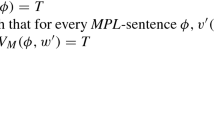Abstract
The use of the temporal logic formalism for representing information is reviewed. Two languages are introduced corresponding to two different ways of viewing information: as an assertion about properties of objects (syntactic view), or as a set of objects (semantic view). We define the semantics of the languages in terms of a model that generalizes the concept of Pawlak's information system.
Similar content being viewed by others
References
J. Bubenko, “The Temporal Dimension in Information Modelling,”Architecture and Models in Data Base Management Systems, G. M. Nijssen, (ed.) (North Holland, New York, 1977), pp. 93–118.
J. P. Burgess, “Logic and Time,”J. Symbolic Logic 44:566–581 (1979).
E. F. Codd, “A Relational Model for Large Shared Data Banks,”Comm. ACM 13:377–387 (1970).
B. Langefors, “Theoretical Analysis in Information Systems,” Student litteratur, Auerbach, Lund., Sweden (1973).
A. Milanowski, “Wartosc kapnografii jako testu czynnosciowego,” Doctoral Dissertation, Medical Academy, Warsaw (1972).
E. Orlowska, “Dynamic information systems,”ICS PAS Reports 434:1–27 (1981).
Z. Pawlak, “Information systems—theoretical foundations,”Infor. Syst. 6:205–218 (1981).
A. Sernadas, “Temporal Aspects of Logical Procedure Definition,”Infor. Syst. 5:167–187 (1980).
Author information
Authors and Affiliations
Rights and permissions
About this article
Cite this article
Orłowska, E. Representation of temporal information. International Journal of Computer and Information Sciences 11, 397–408 (1982). https://doi.org/10.1007/BF00996817
Received:
Revised:
Issue Date:
DOI: https://doi.org/10.1007/BF00996817




